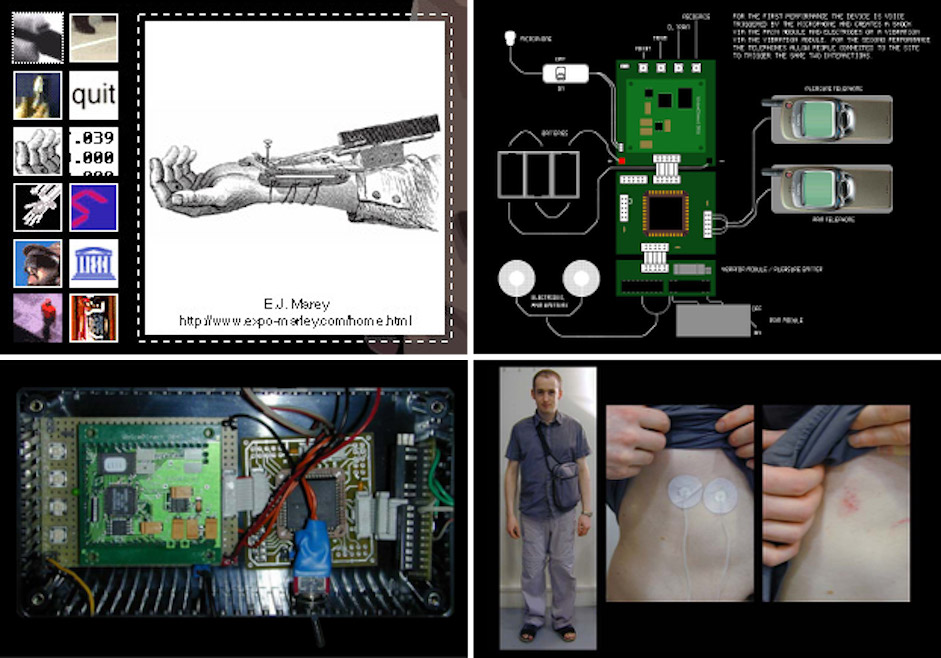For Those Who Fear Intimacy / For Those Who Fear Loneliness

Above: The splash screen for the works original website.
For Those Who Fear Intimacy / For Those Who Fear Loneliness is a work undertaken as part of ARI (Interactive Research Laboratory) at ENSAD (National Superior School of Decorative Arts) in Paris between 2000 and 2001. The work consisted of a custom designed and created wearable electronic device to be employed during two conceived performances. Performance 1 titled For Those Who Fear Intimacy was performed for one week in June of 2001 while performance 2 titled For Those Who Fear Loneliness, which was to use a modified version of the device, remained a concept for future development.
Above: Concept images for both performances. Click image for larger view.
The device for For Those Who Fear Intimacy is voice activated by two words, pain and pleasure, which can only be triggered by me, the person who wears the object. A miniature microphone is permanently clipped close to my mouth so as to rapidly pick up the words if spoken. If my body receives a sensation or more appropriately has an emotional reaction to my environment, the sensation is distilled down via my brain to ether a positive or negative effect. Once I have decided this I vocalise how I feel and this triggers the device. The voice passes on the message to the device as a nerve passes on a message to the brain. Yet here there is the option to falsify the sensation as it has already passed via the brain. Finally the device decodes the vocal input into the appropriate electrical signal to output it to the corresponding emitter, pain or pleasure that is connected directly to my skin to recreate a sensation and close the interactive loop with my own body.
The device serves many functions for me. It can allow me to recreate the same sensation over and over again to intensify that sensation in ether a positive or negative way. Positively, the device could function as a sort of sense enhancer, making me feel more involved and in touch with the moment and my surrounding environment. On the negative side the device could become a sort of vicious circle or biological short circuit, where the time between the original sensation, reaction and the generated sensation is so short that it has adverse effects on me, such as falsifying the sensation, agitating or even stressing me needlessly.
Above: Images of the device created, the website documenting the work and of the final performance. Click image for a gallery of images.
The device for For Those Who Fear Loneliness is a modified version of the electronic device similar in function to that of For Those Who Fear Intimacy. It too was to be worn by me for a performance, however, its purpose and means of triggering are very different. In replace of the microphone which reacts to my vocal commands, here control is handed over to the network and whoever happens to be connected. Users will be able to connect to the device by interacting with a page on the works website. From the webpage they can trigger one of the same two sensations used for For Those Who Fear Intimacy in me, pain or pleasure. Their interaction is sent to me, the interface, via the integration of a mobile phone in the device, which receives the information through an SMS (Short Message Service) text message.
While For Those Who Fear Intimacy is a reflection on self-intimacy and self-control, For Those Who Fear Loneliness is one of loneliness and a possible way of dealing with it, bringing with it both positive and negative results. Here I continue to be the interface however now the user is unknown to me. For Those Who Fear Loneliness doesn’t focus on the idea of loops or short circuits like its counterpart, as the user online feels no physical result of their interaction upon which they can react to interact once again. Instead they have on the webpage a real-time log of all interactions, which updates as soon as the interaction has been sent. For me, the performer, the device is triggered and reacts like before as soon as the mobile phone receives it and sends it on to the device. At no point do I have control over when or how the device is triggered and I can not react to the sensations by re-triggering them. The focus here is on trust, putting myself into the hands of anyone who wants to interact with me. A way of being permanently connected to evade loneliness.
For more information on this work see the works pdf’s in English or here in French.

